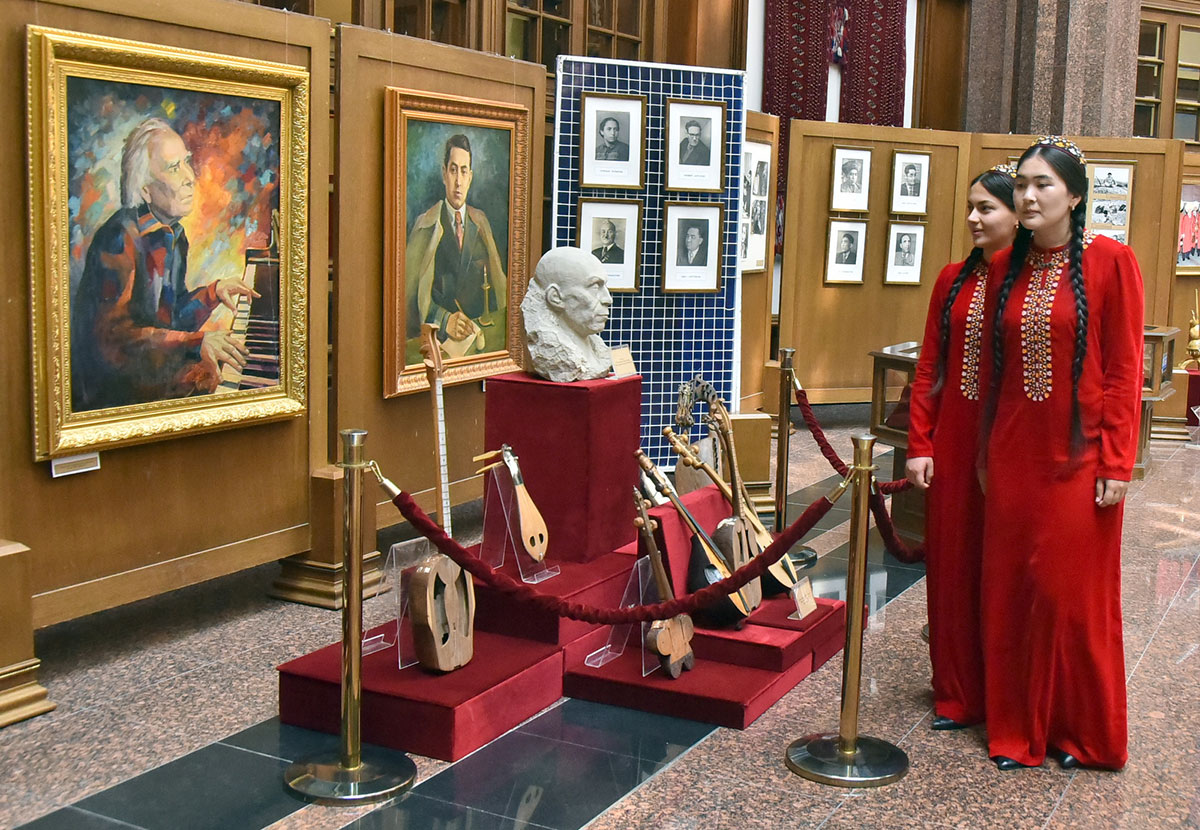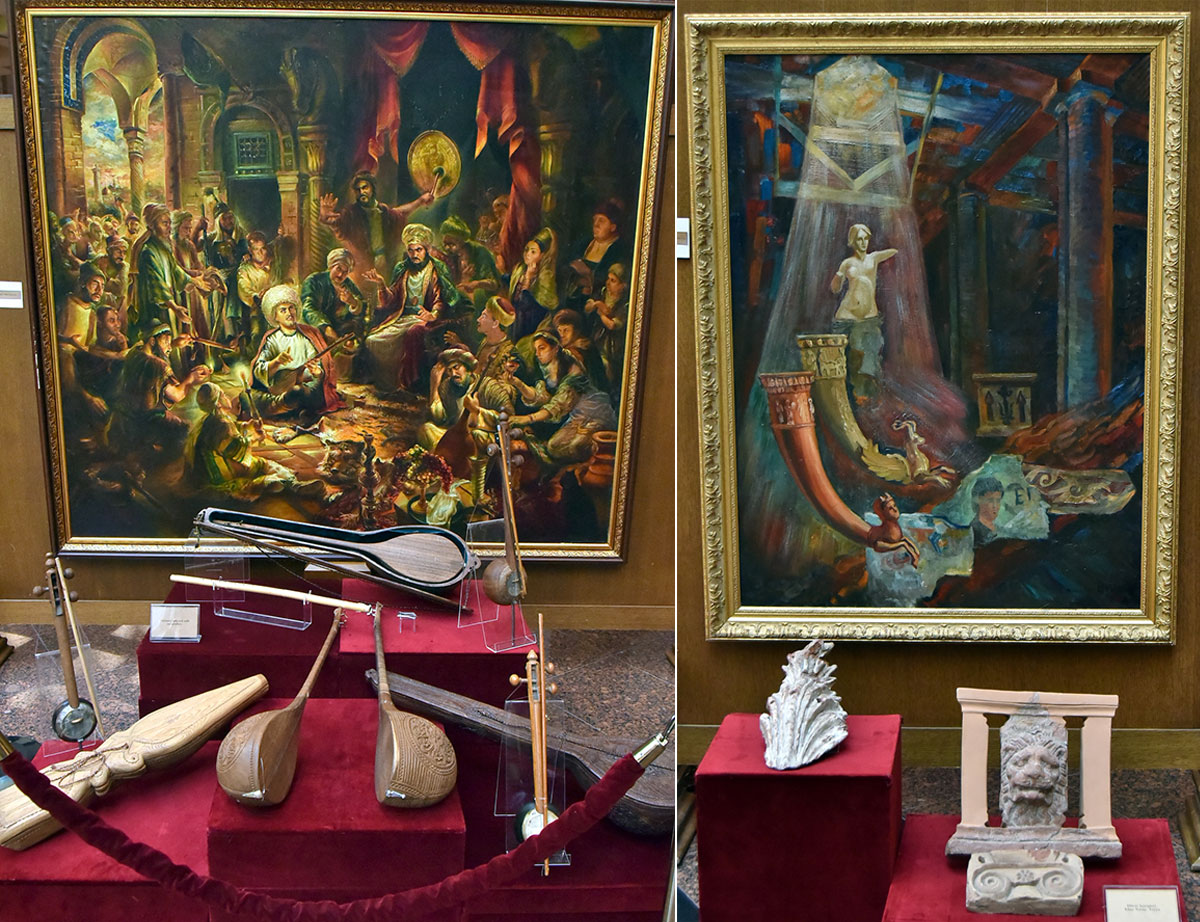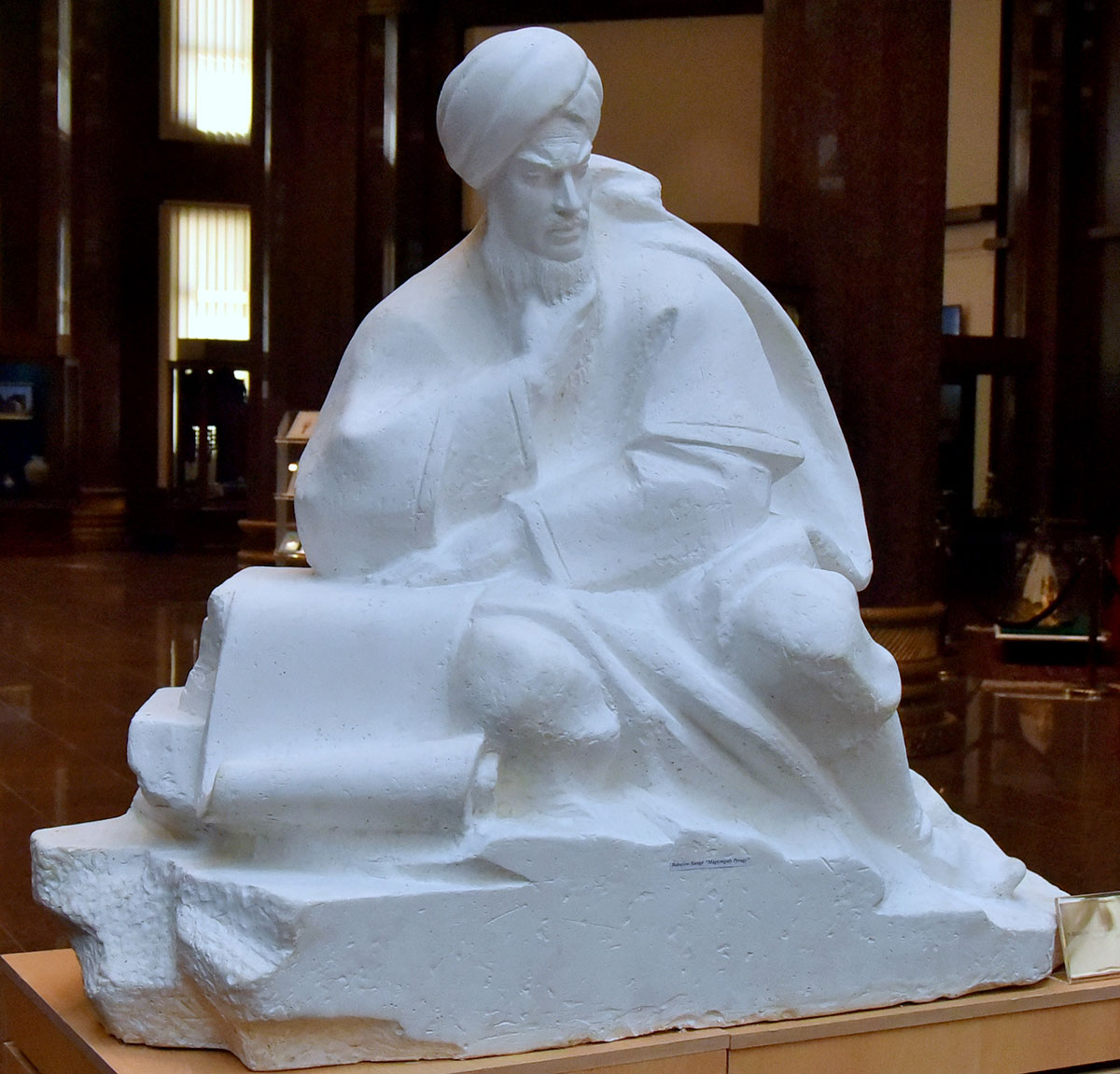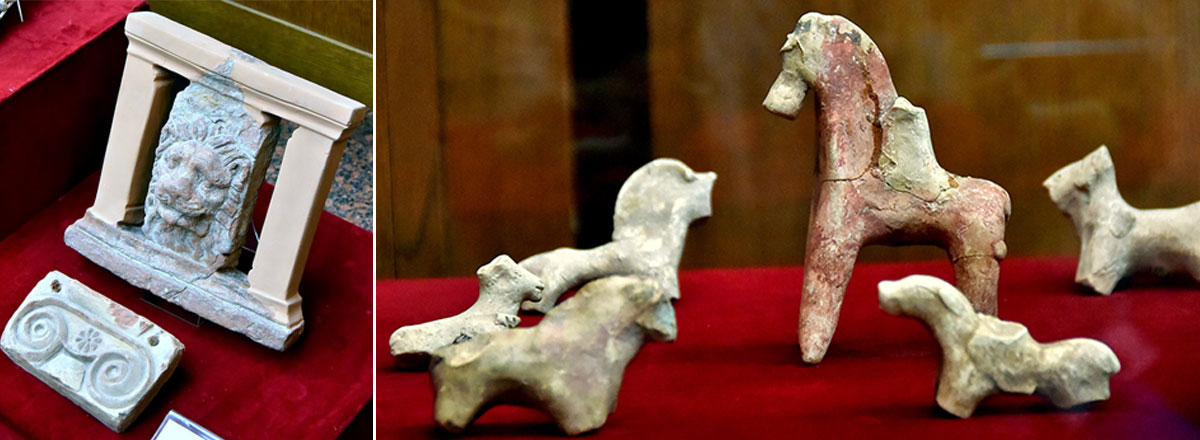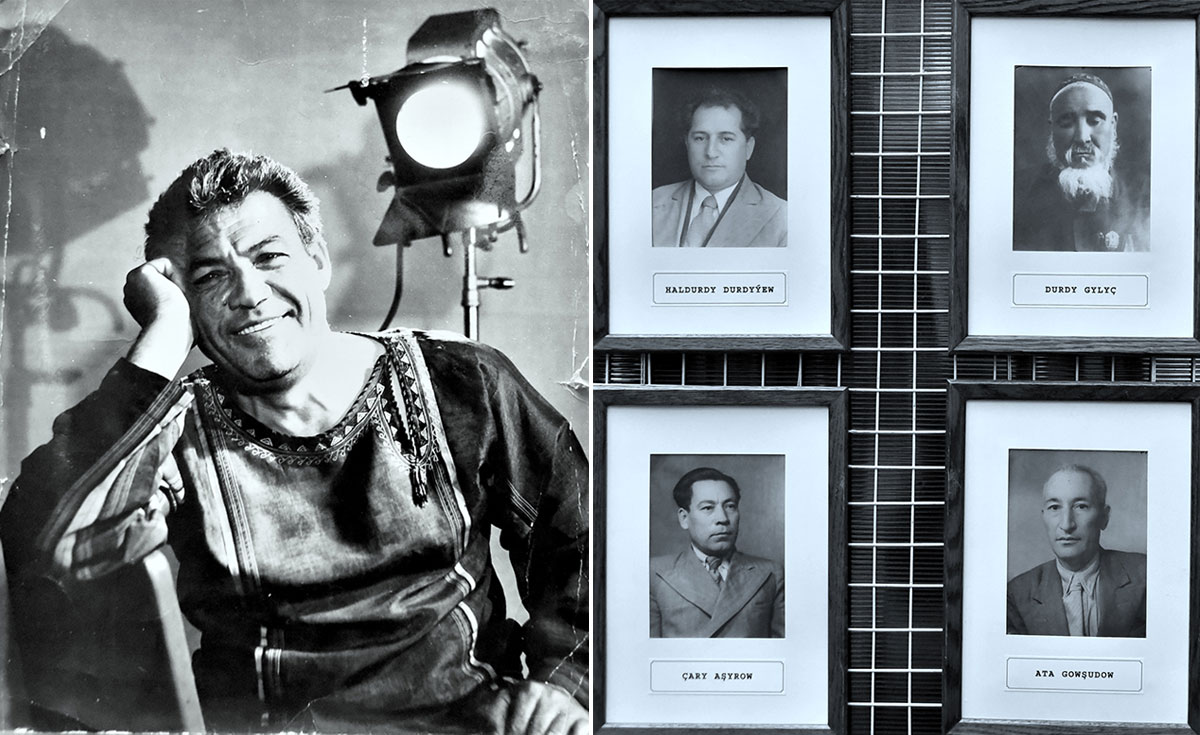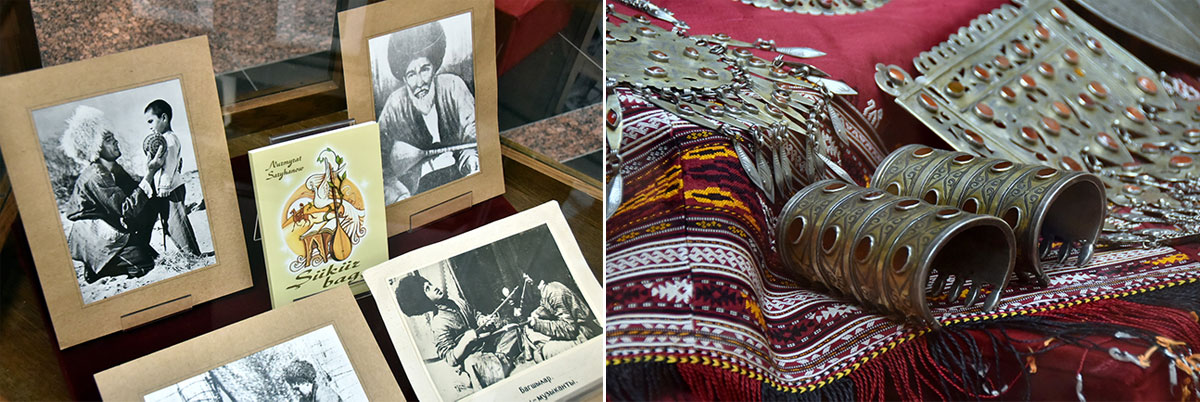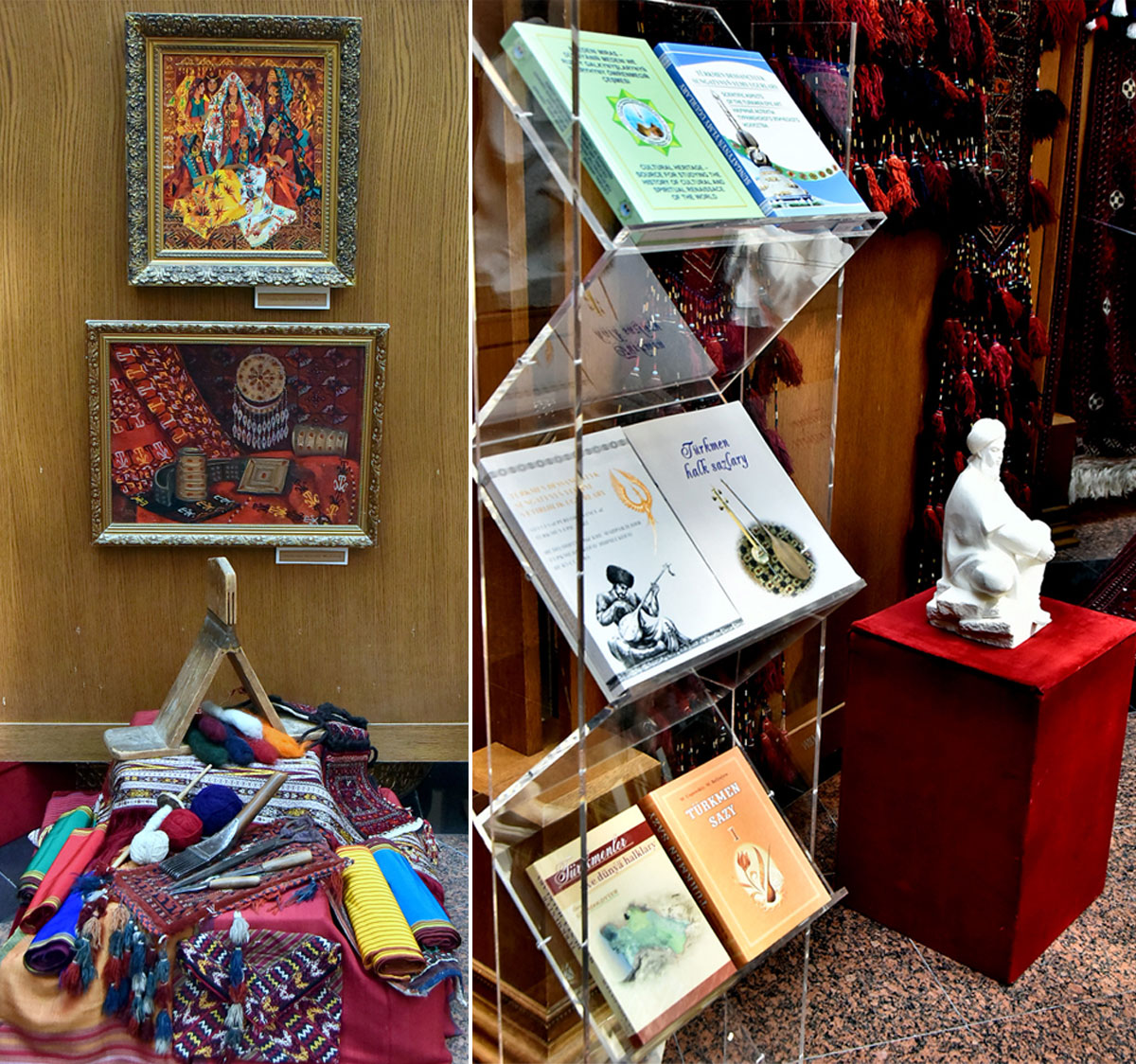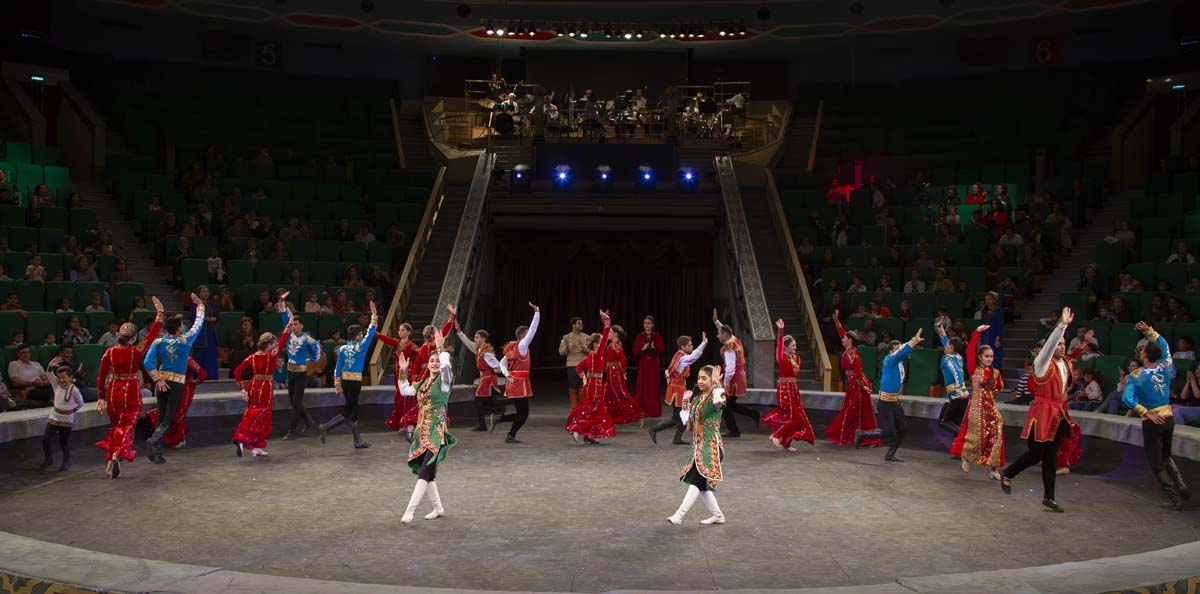The State Museum of the State Cultural Center of Turkmenistan is running an exhibition entitled ‘Culture: The Spiritual Wealth of the Nation’. Dedicated to the development of national culture, and to the great Turkmen poet Magtymguly Pyragy, it consists of several sections…
We began our immersive tour with the section whose conception is a symbolic blend of music and painting. It brings together a bust sculpture of Byashim Nurali, musical instruments made by him, and paintings portraying illustrious Turkmen composers. Also on display are exhibits from the collection of the Museum of the President of Turkmenistan that provide interesting insights into musical traditions of different countries and visually represent a dialogue of cultures.
A collection of jewelry invites visitors to explore the history of Turkmen jewelry making and admire uniquely beautiful pieces made by Turkmen zergers (jewelry makers). On the workbench are a carnelian-encrusted brooch (gulyaka) and an amulet (tumar).
While we were taking a close look at the carpets, Tamara Ilkhanova, a specialist of the department of culture and information, provided us with helpful and in-depth information about the exhibits.
- It is well known that carpet making played a central role in the lives of Turkmens in old times, the art historian said. Not only did carpets have aesthetic value, they were also essential household articles, given the tribes’ nomadic lifestyle. Carpet-making techniques were used to produce many other items, for example bags for storing clothes, kitchen utensils and other things. The interior walls and floors in yurts were covered in carpets.
Used to cover the entrance to the yurt, a carpet hanging called ensi protected the interior living space from the outside elements such as wind, rain, the heat of the sun and cold… Inside, the doorway was adorned with a П-shaped curtain-like gapylyk with brightly colored woolen cords and tassels. When placed outside, a doorstep rug, germech, indicated that nobody was in. It was removed when the family returned home.
As the exhibition’s next section features archeological rarities, the ethnographic objects give place to historical artifacts. On view are fragments of acanthus leaf and lion ornaments. The bas-reliefs from the Round Hall in Old Nisa were embellished with images of these animals because lions were believed to be guardians in the East.
There are many assumptions about the decorative element of the Anau Mosque’s portal - the two dragons facing each other, whose yellow winding bodies were set against a dark blue background in mosaic with small floral motifs. There is still no convincing explanation for the origin of the depiction. The mythical creatures were probably used in protective contexts. There is even a very beautiful legend about them.
Driven by a strong desire to visit the Museum’s archeological hall with its unique exhibits next time when we have free time, we continued our tour of the exhibition. Then, students of the Institute of Culture caught our attention. They were standing by display stands featuring portraits of famous actors and scenes from the movies recognized as national cinematic treasures.
People’s Artist of Turkmenistan, opera singer Murat Bayramgeldyev joined us and I welcomed the chance to ask him about his plans for the upcoming holiday.
- Every year I prepare a new song as a gift for my fellow professionals to mark the day. This year, it will be a song called ‘Turkmenistan: The Land of Neutrality’.
- Since Cultural and Art Workers Day coincides with Magtymguly Pyragy’s Poetry Day, I cannot help but ask about your most favorite poem by the poet.
- It is ‘Türkmeniň’- ‘The Land of the Turkmen’:
“…He is a son of a brave man, his forefathers were brave,
Görogly is his brother, his enthusiasm is high,
If hunters hunt for him in the mountains or steppes,
A Turkmen, the son of a lion, won’t be caught alive.”
- We would like to offer you our congratulations on the holiday. We hope many more spectacular achievements await you ahead.
We began our immersive tour with the section whose conception is a symbolic blend of music and painting. It brings together a bust sculpture of Byashim Nurali, musical instruments made by him, and paintings portraying illustrious Turkmen composers. Also on display are exhibits from the collection of the Museum of the President of Turkmenistan that provide interesting insights into musical traditions of different countries and visually represent a dialogue of cultures.
A collection of jewelry invites visitors to explore the history of Turkmen jewelry making and admire uniquely beautiful pieces made by Turkmen zergers (jewelry makers). On the workbench are a carnelian-encrusted brooch (gulyaka) and an amulet (tumar).
While we were taking a close look at the carpets, Tamara Ilkhanova, a specialist of the department of culture and information, provided us with helpful and in-depth information about the exhibits.
- It is well known that carpet making played a central role in the lives of Turkmens in old times, the art historian said. Not only did carpets have aesthetic value, they were also essential household articles, given the tribes’ nomadic lifestyle. Carpet-making techniques were used to produce many other items, for example bags for storing clothes, kitchen utensils and other things. The interior walls and floors in yurts were covered in carpets.
Used to cover the entrance to the yurt, a carpet hanging called ensi protected the interior living space from the outside elements such as wind, rain, the heat of the sun and cold… Inside, the doorway was adorned with a П-shaped curtain-like gapylyk with brightly colored woolen cords and tassels. When placed outside, a doorstep rug, germech, indicated that nobody was in. It was removed when the family returned home.
As the exhibition’s next section features archeological rarities, the ethnographic objects give place to historical artifacts. On view are fragments of acanthus leaf and lion ornaments. The bas-reliefs from the Round Hall in Old Nisa were embellished with images of these animals because lions were believed to be guardians in the East.
There are many assumptions about the decorative element of the Anau Mosque’s portal - the two dragons facing each other, whose yellow winding bodies were set against a dark blue background in mosaic with small floral motifs. There is still no convincing explanation for the origin of the depiction. The mythical creatures were probably used in protective contexts. There is even a very beautiful legend about them.
Driven by a strong desire to visit the Museum’s archeological hall with its unique exhibits next time when we have free time, we continued our tour of the exhibition. Then, students of the Institute of Culture caught our attention. They were standing by display stands featuring portraits of famous actors and scenes from the movies recognized as national cinematic treasures.
People’s Artist of Turkmenistan, opera singer Murat Bayramgeldyev joined us and I welcomed the chance to ask him about his plans for the upcoming holiday.
- Every year I prepare a new song as a gift for my fellow professionals to mark the day. This year, it will be a song called ‘Turkmenistan: The Land of Neutrality’.
- Since Cultural and Art Workers Day coincides with Magtymguly Pyragy’s Poetry Day, I cannot help but ask about your most favorite poem by the poet.
- It is ‘Türkmeniň’- ‘The Land of the Turkmen’:
“…He is a son of a brave man, his forefathers were brave,
Görogly is his brother, his enthusiasm is high,
If hunters hunt for him in the mountains or steppes,
A Turkmen, the son of a lion, won’t be caught alive.”
- We would like to offer you our congratulations on the holiday. We hope many more spectacular achievements await you ahead.




